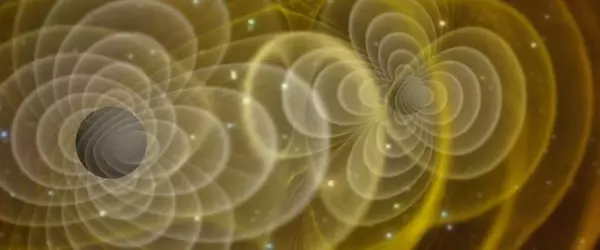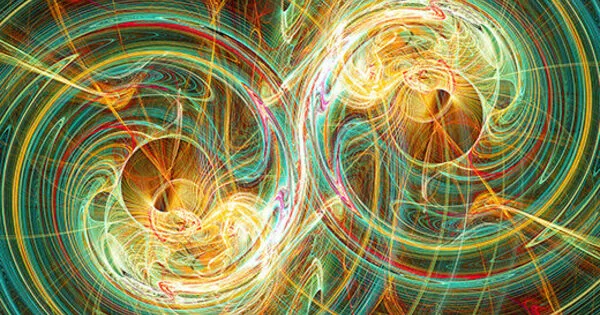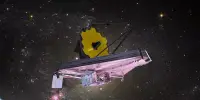A multinational team of astronomers, including scientists from the University of Birmingham’s Institute for Gravity Wave Astronomy, has announced the findings of a comprehensive search for a background of ultra-low frequency gravitational waves.
These light-year-scale ripples, a result of Einstein’s general theory of relativity, permeate all of spacetime and could be caused by mergers of the Universe’s most massive black holes or by events that occurred shortly after the Big Bang. For decades, scientists have been looking for definitive evidence of these signals.
The International Pulsar Timing Array (IPTA), joining the work of several astrophysics collaborations from around the world, recently completed its search for gravitational waves in their most recent official data release, known as Data Release 2 (DR2).
This data set consists of precision timing data from 65 millisecond pulsars — stellar remnants which spin hundreds of times per second, sweeping narrow beams of radio waves that appear as pulses due to the spinning — obtained by combining the independent data sets from the IPTA’s three founding members: The European Pulsar Timing Array (EPTA), the North American Nanohertz Observatory for Gravitational Waves (NANOGrav), and the Parkes Pulsar Timing Array in Australia (PPTA).
The combined data show significant evidence for an ultra-low frequency pulse detected by many of the pulsars. The parameters of this signal are broadly consistent with those expected from a gravitational wave “background.”
The detection of gravitational waves from a population of massive black hole binaries or from another cosmic source will give us unprecedented insights into how galaxy form and grow, or cosmological processes taking place in the infant universe.
The gravitational wave background is made up of many different overlapping gravitational-wave signals emitted by the cosmic population of supermassive binary black holes (two supermassive black holes orbiting each other and eventually merging) – similar to background noise from many overlapping voices in a crowded hall.
Professor Alberto Vecchio
This result further strengthens the gradual emergence of similar signals that have been found in the individual data sets of the participating pulsar timing collaborations over the past few years.
Professor Alberto Vecchio, Director of the Institute for Gravitational Wave Astronomy at the University of Birmingham, and member of the EPTA, says: “The detection of gravitational waves from a population of massive black hole binaries or from another cosmic source will give us unprecedented insights into how galaxy form and grow, or cosmological processes taking place in the infant universe. A major international effort of the scale of IPTA is needed to reach this goal, and the next few years could bring us a golden age for these explorations of the universe.”
“This is a very exciting signal! Although we do not have definitive evidence yet, we may be beginning to detect a background of gravitational waves,” says Dr Siyuan Chen, a member of the EPTA and NANOGrav, and the leader of the IPTA DR2 search and publication.
The PPTA’s Dr. Boris Goncharov warns about the potential interpretations of such common signals: “We’re also investigating what else this signal could be. For example, it could be caused by noise in individual pulsar data that has been incorrectly modeled in our calculations.”
The IPTA must detect spatial correlations between pulsars in order to identify the gravitational-wave background as the source of this ultra-low frequency signal. This means that depending on their separation in the sky, each pair of pulsars must respond to gravitational waves in a very specific way.

These characteristic correlations between pulsar couples serve as the “smoking gun” for detecting a gravitational-wave background. Without them, it is impossible to demonstrate that the signal was not caused by another process. Surprisingly, the first indicator of a gravitational wave background would be a common signal, such as that detected in the IPTA DR2. Further data collecting, enlarged arrays of observed pulsars, and continuing searches of the ensuing longer and larger data sets will determine whether or if this spectrally comparable ultra-low frequency signal is connected between pulsars in accordance with theoretical predictions.
Consistent signals like the one recovered with the IPTA analysis have also been published in individual data sets more recent than those used in the IPTA DR2, from each of the three founding collaborations. The IPTA DR2 analysis demonstrates the power of the international combination giving strong evidence for a gravitational wave background compared to the marginal or absent evidences from the constituent data sets. Additionally, new data from the MeerKAT telescope and from the Indian Pulsar Timing Array (InPTA), the newest member of the IPTA, will further expand future data sets.
“A signal like that detected in the IPTA DR2 would be the first indication of a gravitational wave background. The signal will then become more significant and reveal spatial correlations as more data is collected, at which time we will know it is a gravitational wave background. We are really excited to contribute several years of new data to the IPTA for the first time in order to aid in the discovery of gravitational waves “According to Dr. Bhal Chandra Joshi, an InPTA member.
Given the most recent reported results from the separate groups, which can now all clearly recover the common signal, the IPTA is enthusiastic about what might be accomplished once these are integrated into IPTA Data Release 3. Work on this new data release, which will include updated data sets from the IPTA’s four constituent PTAs, is currently underway. The DR3 data set analysis is scheduled to be completed within the next few years.
“If the signal we are currently seeing is the first hint of a gravitational wave background, then based on our simulations, it is possible that we will have more definite measurements of the spatial correlations necessary to conclusively identify the origin of the common signal in the near future,” says Dr. Maura McLaughlin of the NANOGrav collaboration.















